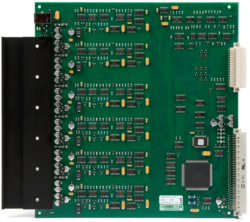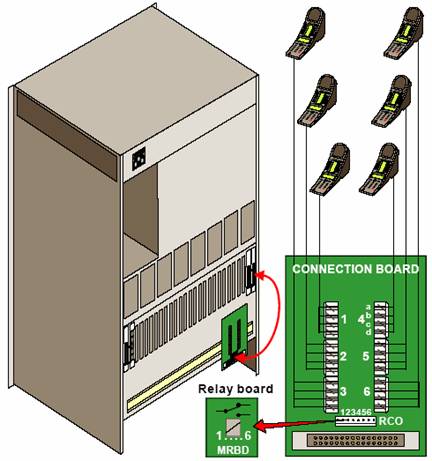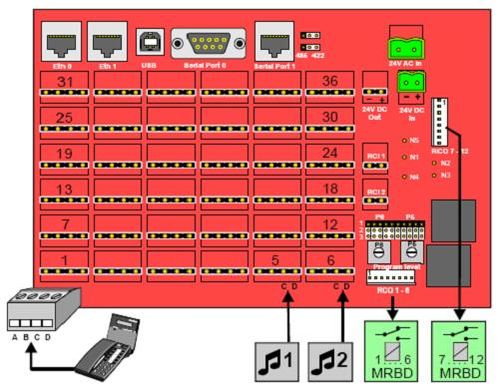ASLT - AlphaCom Subscriber Line Board: Difference between revisions
From Zenitel Wiki
| (4 intermediate revisions by 3 users not shown) | |||
| Line 1: | Line 1: | ||
{{A}} [[Image:1009101010.PNG|thumb|250px|ASLT Subscriber Line Board (1009101010)]] | {{A}} [[Image:1009101010.PNG|thumb|250px|ASLT Subscriber Line Board (1009101010)]] | ||
The ASLT line board is used for connection of [[: | The ASLT line board is used for connection of [[:Category:Stations#Analog_4-wire_stations|analog intercom stations]] to the AlphaCom server. | ||
==Highlights == | ==Highlights== | ||
* Each board provides six 4-wire subscriber connections | |||
* 6 [[RCO|RCO remote control outputs]] (software configurable activation) | *Each board provides six 4-wire subscriber connections | ||
* 1 voice-switched conversation per board | *6 [[RCO|RCO remote control outputs]] (software configurable activation) | ||
* When using handset or full duplex conference unit at both ends, the system is non-blocking within each module | *1 voice-switched conversation per board | ||
* All subscriber connections suitable for display stations | *When using handset or full duplex conference unit at both ends, the system is non-blocking within each module | ||
* Line monitoring | *All subscriber connections suitable for display stations | ||
* Software-controlled output volume control | *Line monitoring | ||
* [[Hot-plug|Hot plug-in/plug-out]] | *Software-controlled output volume control | ||
* Red/green/amber LED indicates system status | *[[Hot-plug|Hot plug-in/plug-out]] | ||
*Red/green/amber LED indicates system status | |||
| Line 18: | Line 19: | ||
* ''Turn power off before inserting or removing boards'' | * ''Turn power off before inserting or removing boards'' | ||
* ''Alternatively use the [[Hot-plug|Hot-plug cable]] to insert/remove boards'' }} | * ''Alternatively use the [[Hot-plug|Hot-plug cable]] to insert/remove boards'' }} | ||
* In the [[AlphaCom XE20]] the ASLT board can be placed in any board position 1 and 8-23. | *In the [[AlphaCom XE26]] the ASLT board can be placed in any board position 1-23. | ||
** | **Board position 1: Physical numbers 1 to 6 | ||
** | **Board position 2: Physical numbers 7 to 12 | ||
** ! | **! | ||
** ! | **! | ||
** | **Board position 23: Physical numbers 133 to 138 | ||
*In the [[AlphaCom XE20]] the ASLT board can be placed in any board position 1 and 8-23. | |||
**Board position 1: Physical numbers 1 to 6 | |||
**Board position 8: Physical numbers 43 to 48 | |||
**! | |||
**! | |||
**Board position 23: Physical numbers 133 to 138 | |||
{{Obs|Board position 2 to 7 (physical numbers 7 to 42) does not exist in the AlphaCom XE20!}} | {{Obs|Board position 2 to 7 (physical numbers 7 to 42) does not exist in the AlphaCom XE20!}} | ||
There are three different subscriber connection methods available: | There are three different subscriber connection methods available: | ||
*Subscriber connection board ([[Subscriber Connection Board|1009930200]]) with 1.5 m connection cables ([[1009501011]]) or 3.0 m connection cable. 2 sets of [[Subscriber Connection Board|1009930200]] and [[1009501011]] are included with the XE20 and XE26 exchange packages.<br> | *Subscriber connection board ([[Subscriber Connection Board|1009930200]]) with 1.5 m connection cables ([[1009501011]]) or 3.0 m connection cable. 2 sets of [[Subscriber Connection Board|1009930200]] and [[1009501011]] are included with the XE20 and XE26 exchange packages.<br> | ||
*5 m ([[1009501021]]) and 10 m ([[1009501023]]) subscriber connection cables. These cables are un-terminated, [[1009501023#Color_codes|color code]] is packed with the cables. | *5 m ([[1009501021]]) and 10 m ([[1009501023]]) subscriber connection cables. These cables are un-terminated, [[1009501023#Color_codes|color code]] is packed with the cables. | ||
| Line 45: | Line 48: | ||
==Installation in AlphaCom XE7== | ==Installation in AlphaCom XE7== | ||
* In the [[AlphaCom XE7]] the ASLT board can be placed in any board position 1-6. | |||
** Bord position 1: Physical numbers 1 to 6 | *In the [[AlphaCom XE7]] the ASLT board can be placed in any board position 1-6. | ||
** Bord position 2: Physical numbers 7 to 12 | **Bord position 1: Physical numbers 1 to 6 | ||
** ! | **Bord position 2: Physical numbers 7 to 12 | ||
** ! | **! | ||
** Bord position 6: Physical numbers 31 to 36 | **! | ||
**Bord position 6: Physical numbers 31 to 36 | |||
{{obs| | {{obs| | ||
| Line 63: | Line 67: | ||
{{note|Physical numbers 5 and 6 are by default used as inputs for Audio Program distribution, but can alternatively be used for intercom stations. See related article: [[Physical number 5 and 6 (AlphaCom E7)]] }} | {{note|Physical numbers 5 and 6 are by default used as inputs for Audio Program distribution, but can alternatively be used for intercom stations. See related article: [[Physical number 5 and 6 (AlphaCom E7)]] }} | ||
== Cabling == | ==Cabling== | ||
The cabling from the AlphaCom server to the intercom station is star wiring principle. Use twisted pair cable. Two pairs of wires are required to each station. The maximum distance depends on the cable diameter: | The cabling from the AlphaCom server to the intercom station is star wiring principle. Use twisted pair cable. Two pairs of wires are required to each station. The maximum distance depends on the cable diameter: | ||
The wires are called a-,b-, c- and d-wires. a-b-wires are "transmit" and cd-wires are "receive". | *0.5 mm wires (AWG24): 1.4 km | ||
*0.6 mm wires (AWG22): 2.0 km | |||
*0.9 mm wires (AWG19): 4.0 km | |||
The four wires are called a-,b-, c- and d-wires. a-b-wires are "transmit" and cd-wires are "receive". | |||
{{note|a- and b-wire must be in one pair, and c- and d-wire in another pair}} | {{note|a- and b-wire must be in one pair, and c- and d-wire in another pair}} | ||
| Line 77: | Line 82: | ||
<br> | <br> | ||
=== Voltage readings === | ===Voltage readings=== | ||
For troubleshooting it might be useful to check the voltage on the lines with a voltmeter. | For troubleshooting it might be useful to check the voltage on the lines with a voltmeter. | ||
| Line 85: | Line 90: | ||
Typical voltages across a- and b-wire: | Typical voltages across a- and b-wire: | ||
* Open line (no station connected): 32V | |||
* Display station connected: 24-27V | *Open line (no station connected): 32V | ||
* Non-display station connected: 29-30V | *Display station connected: 24-27V | ||
*Non-display station connected: 29-30V | |||
Typical voltages across c- and d-wire: | Typical voltages across c- and d-wire: | ||
* Open line, or station connected in Open mode: -21V | |||
* Station connected in Private mode: -19V | *Open line, or station connected in Open mode: -21V | ||
* Station in conversation: +9 to +12V | *Station connected in Private mode: -19V | ||
*Station in conversation: +9 to +12V | |||
<br> | <br> | ||
== Additional Documentation on Zenitel.com == | ==Additional Documentation on Zenitel.com== | ||
* [http://www.zenitel.com/product/aslt Additional Documentation on Zenitel.com] | |||
*[http://www.zenitel.com/product/aslt Additional Documentation on Zenitel.com] | |||
[[Category:Feature boards]] | [[Category:Feature boards]] | ||
Latest revision as of 13:52, 17 September 2021
The ASLT line board is used for connection of analog intercom stations to the AlphaCom server.
Highlights
- Each board provides six 4-wire subscriber connections
- 6 RCO remote control outputs (software configurable activation)
- 1 voice-switched conversation per board
- When using handset or full duplex conference unit at both ends, the system is non-blocking within each module
- All subscriber connections suitable for display stations
- Line monitoring
- Software-controlled output volume control
- Hot plug-in/plug-out
- Red/green/amber LED indicates system status
Installation in AlphaCom XE20/XE26

|
|
- In the AlphaCom XE26 the ASLT board can be placed in any board position 1-23.
- Board position 1: Physical numbers 1 to 6
- Board position 2: Physical numbers 7 to 12
- !
- !
- Board position 23: Physical numbers 133 to 138
- In the AlphaCom XE20 the ASLT board can be placed in any board position 1 and 8-23.
- Board position 1: Physical numbers 1 to 6
- Board position 8: Physical numbers 43 to 48
- !
- !
- Board position 23: Physical numbers 133 to 138
There are three different subscriber connection methods available:
- Subscriber connection board (1009930200) with 1.5 m connection cables (1009501011) or 3.0 m connection cable. 2 sets of 1009930200 and 1009501011 are included with the XE20 and XE26 exchange packages.
- 5 m (1009501021) and 10 m (1009501023) subscriber connection cables. These cables are un-terminated, color code is packed with the cables.
- Filter and connection card 1009501041 with RJ45 connectors.
Installation in AlphaCom XE7
- In the AlphaCom XE7 the ASLT board can be placed in any board position 1-6.
- Bord position 1: Physical numbers 1 to 6
- Bord position 2: Physical numbers 7 to 12
- !
- !
- Bord position 6: Physical numbers 31 to 36
Stations are connected to the AlphaCom XE7 by means of pluggable screw terminals on the backplane.
There are 12 RCO outputs available on pinheaders on the backplane. RCO 1-6 are controlled by the ASLT board in position 1, and RCO 7-12 are controlled by the ASLT board in position 2.

|
Physical numbers 5 and 6 are by default used as inputs for Audio Program distribution, but can alternatively be used for intercom stations. See related article: Physical number 5 and 6 (AlphaCom E7) |
Cabling
The cabling from the AlphaCom server to the intercom station is star wiring principle. Use twisted pair cable. Two pairs of wires are required to each station. The maximum distance depends on the cable diameter:
- 0.5 mm wires (AWG24): 1.4 km
- 0.6 mm wires (AWG22): 2.0 km
- 0.9 mm wires (AWG19): 4.0 km
The four wires are called a-,b-, c- and d-wires. a-b-wires are "transmit" and cd-wires are "receive".
Voltage readings
For troubleshooting it might be useful to check the voltage on the lines with a voltmeter.
Typical voltages across a- and b-wire:
- Open line (no station connected): 32V
- Display station connected: 24-27V
- Non-display station connected: 29-30V
Typical voltages across c- and d-wire:
- Open line, or station connected in Open mode: -21V
- Station connected in Private mode: -19V
- Station in conversation: +9 to +12V





